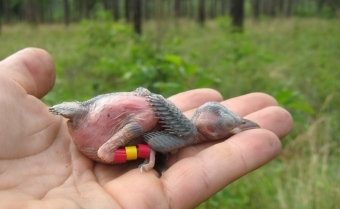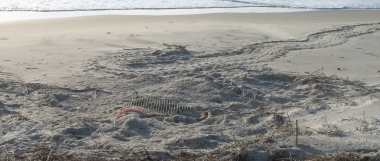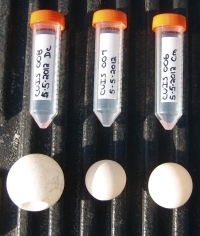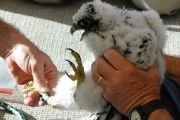|
Silver lining for rare woodpeckers
 Red-cockaded upswing tracked at Silver Lake WMA
Joe Burnam, a wildlife biologist with DNR’s Nongame Conservation Section, banded young woodpeckers at the WMA near Bainbridge earlier this month. Burnam had monitored the cavity nests in longleaf pines weekly since mid-April. At 5 to 10 days old, the birds were gently fished out and banded – a metallic U.S. Fish and Wildlife Service band and a color band on one leg, and three color bands on the opposite leg.
Unique color combinations allow biologists to identify a bird in the wild.
Burnam’s banding at Silver Lake underscored an upward trend in the only population of red-cockaded woodpeckers on state land. So far, 19 nests have been found at Silver Lake, part of 25 active red-cockaded woodpecker clusters, or family groups, on the WMA. An active cluster is a collection of trees with cavities used and defended by a single group of woodpeckers. Silver Lake had 19 active clusters when DNR acquired the 8,400 acres in 2008.
Silver Lake's red-cockaded woodpeckers have benefited from biologists installing artificial nest cavities in longleaf pines – this species is the only North American woodpecker that excavates cavities in live trees – and adding birds from other sites such as at Apalachicola National Forest and Eglin Air Force Base ( “Newcomers settling in at Silver Lake,” October 2010). “A couple of females we’ve moved in have paired up and are nesting this year,” Burnam said. Habitat management including dormant and growing-season burns is another factor. “Fire helps control hardwood and shrub encroachment into longleaf (pine) communities,” Burnam explained. Because red-cockaded woodpeckers will not tolerate a hardwood midstory, “fire helps maintain suitable nesting and foraging habitat.”
Prescribed fire during spring and early summer also stimulates flowering and seed production of some native plants, which likely has a positive impact on insects the woodpeckers eat, as well as many other wildlife species in the longleaf ecosystem, according to Burnam.
Considering that red-cockaded woodpeckers are imperiled because of habitat loss, the effort and the species’ response add up to some rich news for a very rare bird.
Other woodpecker work
-
DNR also monitored red-cockaded woodpeckers this year at Moody Forest Wildlife Management Area in Appling County and banded nestlings at private Pebble Hill Plantation, a Safe Harbor participant near Thomasville.
-
In 1999, DNR developed the nation’s first statewide Red-cockaded Woodpecker Habitat Conservation Plan to provide management options for private landowners. Now, 156,997 acres are enrolled in Safe Harbor management agreements covering more than 100 woodpecker groups, mostly in the Red Hills Region near Thomasville.
 Cumberland Island
Biologist witnesses sea turtle ‘hat trick’
Doug Hoffman admits he doesn’t sleep much during sea turtle nesting season. Protecting nests on Cumberland Island from predators like hogs, raccoons, armadillos and coyotes keeps the National Park Service biologist up most nights. But the sea turtle hat trick Hoffman witnessed May 4 made the bleary-eyed patrols even more worthwhile.
Hoffman was on Cumberland’s north end when a green sea turtle emerged from the surf just after 10 p.m. She crawled to the base of the dune he was perched on and began to lay eggs. Four hours later, Hoffman spotted another turtle 100 yards away. He checked after she began laying: a loggerhead, Georgia’s primary nesting sea turtle. As she was crawling for higher ground, another turtle left the surf farther south. Hoffman also gave her time to start laying, then went closer.
“Imagine my surprise when I walked up on a leatherback (sea turtle) actively digging,” he wrote. Hoffman had seen all of the sea turtle species that nest on Georgia beaches, well, nesting. He later wrote: “I wonder if this is the first time someone has witnessed all three species of Georgia nesters actually nest on the same beach in the same night? Even more unbelievable is the short stretch of beach that it all occurred on.”
A biologist at the National Seashore since 2006, Hoffman has seen hundreds of turtles nest, though this was his first leatherback. He kept close watch on these nests because coyotes roam the beach and he wanted to make sure the eggs were protected by wire screen. (Leatherback egg chambers can be difficult to find. “They’ll tear up an area big enough for two trucks to park,” Hoffman said.)
Because the three nests were below the spring high-tide line, Hoffman relocated them to higher ground the next morning to prevent any eggs being inundated by tides and lost. That evening and the next two, tides associated with a “ super moon” washed out the three original nest sites. Hoffman said the leatherback nest contained 88 eggs; the green, 130; and the loggerhead, 121.
(Pictured below: An egg from each nest, from left, leatherback, loggerhead and green.)
 Sea turtle insights
-
Cumberland recorded its first predation of a sea turtle nest by coyotes last year.
-
Comprehensive day and night predator management activities on the island have reduced nest predation rates from 67 percent in 2000 to less than 5 percent a year over the last 11 years.
-
Nesting at Cumberland has been “wide open” so far this year, Hoffman said. The island scored the year’s first loggerhead nest – April 25 – and has recorded more than 80 since. The statewide total has topped 320. Click for updates.
-
It’s not known whether the early surge will lead to a stronger season. Last year’s state count of 1,992 loggerhead nests marked the most since comprehensive surveys began in 1989. The total including leatherback and green sea turtle nests was 2,004.
-
So far this year, 88 sea turtles had been found dead, sick or injured on Georgia beaches, continuing 2012’s unfortunate lead in strandings through the same period since at least 2007. Almost half -- 41 -- showed injuries consistent with being hit by a boat. Tips for avoiding turtles.
-
Support conservation of sea turtles and other nongame wildlife in Georgia. Here's how.
|
Noteworthy
 |
|
Red-cockaded woodpeckers weren’t the only rare birds banded this month. Nongame Program Manager Jim Ozier banded three peregrine falcon nestlings May 9 on SunTrust Plaza, where the raptors nest high above Atlanta (photos). Nongame staff also banded 35 wood stork chicks near St. Mary’s.
The Liberty County Commission chairman proclaimed endangered species day May 18 as Frosted Flatwoods Salamander Day, and the
|
logo of the local convention and visitors bureau sports “Sal the Salamander.” Why is the federally listed amphibian favored in this deep south Georgia county? Bureau Executive Director Ryan Willett explains.
Eastern diamondback rattlesnakes warrant further study to determine whether the species should be protected under the federal Endangered Species Act. The U.S. Fish and Wildlife Service’s 90-day finding has triggered a comprehensive status review of these heavyweight rattlers once abundant in longleaf pine ecosystems across the Southeast (map of historic range).
Thirty-one juvenile eastern indigo snakes released at Conecuh National Forest continued efforts to reestablish the federally threatened snake in an area of Alabama where it once flourished. Nongame Program Manager Matt Elliott and senior wildlife biologist John Jensen helped collect the gravid indigos in Georgia that produced the young snakes. The discovery of two gravid indigos at Conecuh this year raised hopes that the re-introduction is working.
More whorled sunflower sites, some with thousands of stems, have been found at Coosa Valley Prairies in Floyd County by Malcolm Hodges, state stewardship director for The Nature Conservancy. Referring to Hodges' comments about years of prescribed fire possibly spurring this plant state-listed as endangered in Georgia, Nongame botanist Tom Patrick called the discovery “one of the best stories" he has heard about fire effects and rare plants.
 |
|
Visitors to the Wildlife Resources Division’s Conservation Center in Social Circle can see what a Coastal Plain pitcherplant bog looks like. A small garden funded by TERN and organized by Carrie Radcliffe ( right), mountain bog project coordinator for the Georgia Plant Conservation Alliance, and Nongame botanist Lisa Kruse ( left) features pitcherplants donated by Atlanta Botanical Garden.
About 50 Florida sandhill cranes, including some pairs and three active nests, were spotted at
|
Trapping bluebirds and other songbirds led to some blue times for a Gilmer County man. After receiving a complaint, DNR Sgt. John VanLandingham, Ranger 1st Class Joe Hill and Gilmer County Sheriff’s deputies visited the home May 14 and discovered 174 marijuana plants being grown in the basement. Since, five bluebirds and another songbird have been released into the wild, and the suspect has been charged with illegal possession of the birds and manufacturing marijuana. ( Read or sign up to receive Wildlife Resources' weekly law enforcement reports!)
A Naples, Fla., man pleaded guilty last week to killing an endangered Florida panther in 2009. Todd Alan Benfield, 45, faces maximum penalties of up to a year in prison and a $100,000 fine for shooting the panther while bowhunting and then hiding the carcass.
Names in the news: Nongame Conservation botanist Mincy Moffett Jr. wrote a comprehensive profile of Ohoopee Dunes Natural Area for The (Swainsboro) Forest-Blade’s “progress” edition. Biologist Clay George co-authored a paper that will be published in Marine Mammal Science and summarizes the disentanglement and subsequent necropsy of a juvenile right whale that died from entanglement wounds in 2011.
Event updates: JAKES Day at Charlie Elliott Wildlife Center drew a crowd of more than 1,300. The Georgia Mountain BirdFest at Unicoi State Park was also a success, but the 2013 event will be held at Amicalola Falls State Park and Lodge April 25-28 because of renovations at Unicoi. Nongame Conservation had a strong role, again, in Swainsboro’s Pine Tree Festival, providing booths, a wildlife display and even hiking tours of Ohoopee Dunes Natural Area. Georgia Power played host to Southern Company’s annual Stewardship Partners Meeting, where the take-home message was the importance of public partnerships with private landowners to conserving and restoring longleaf pine ecosystems.
Headlines
Parting shot

A whimbrel sizes up a moving food source – fiddler crabs – on St. Simons Island. Nongame
month. One, named Postel, was recently roosting on Georgia’s Little Egg Island Bar.
Another, called Gould, has migrated to Great Slave Lake in Canada's Northwest Territories
(now Nunavut), documenting for the first time a whimbrel from Georgia joining the species'
western breeding population. (The eastern population breeds in the Hudson Bay area.)
The transmitters can work for years, providing information about migration routes, timing
and stopover sites, including those in Georgia critical to these wide-ranging shorebirds.
Click here to follow Gould, Postel and Hope, a whimbrel that survived flying through the
center of Tropical Storm Gert last summer.
Credits
** Masthead: Young peregrines in nest on SunTrust Plaza. David Allen/Ga. DNR
** Red-cockaded woodpecker nestling, with bands. Christina Perez
** Leatherback sea turtle nest site on Cumberland Island. Doug Hoffman/National Park Service
** Egg samples from the three sea turtle nests. Doug Hoffman/National Park Service
** Banding a young peregrine at the offices of McKenna Long & Aldridge law firm. David Allen/Ga. DNR
** Carrie Radcliffe and Lisa Kruse at pitcherplant bog garden. Linda May/Ga. DNR
** Whimbrel on St. Simons Island. Brad Winn/Manomet Center for Conservation Science

Give wildlife a chance!
The Nongame
Conservation Section of DNR's Wildlife Resources Division receives no state funds to
conserve nongame wildlife, native plants and natural habitats. Instead, we
depend on contributions, grants and fundraisers, such as the eagle and
hummingbird license plates. How can you help?
|